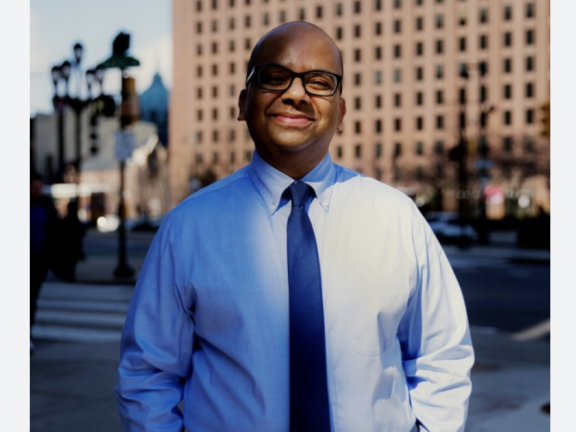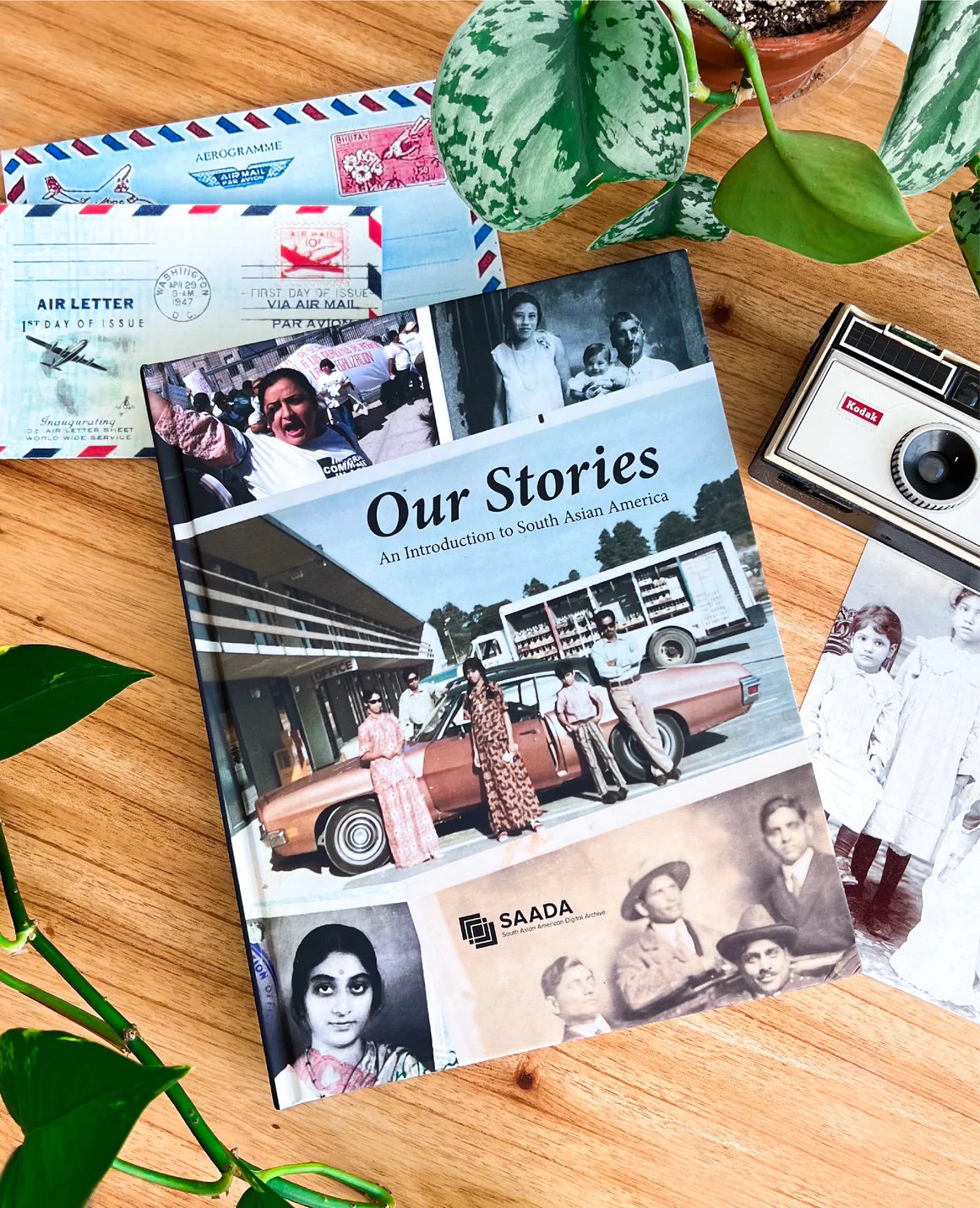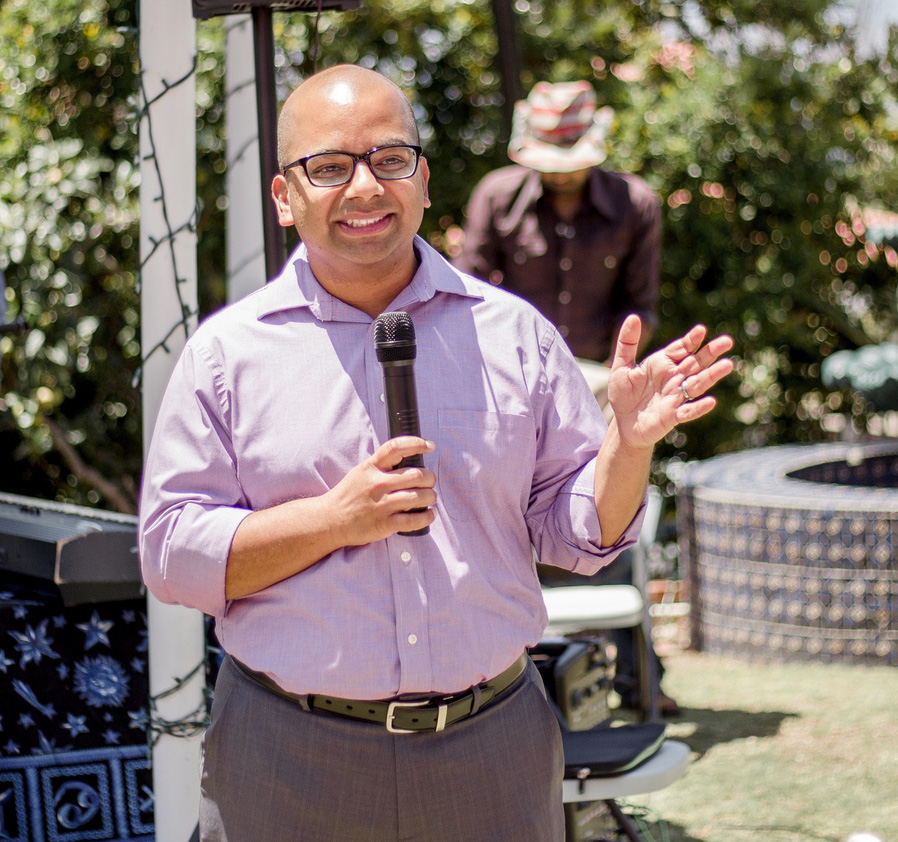A Global Conversation with Samip Mallick

Samip Mallick, co-founder and executive director of the South Asian American Digital Archive (SAADA), turned a personal journey for belonging into a meaningful professional endeavor that has touched the lives of thousands of people across America. As the child of immigrants, Mallick often felt caught between cultures, inspiring him to explore the rich, yet often overlooked, history of South Asian Americans. That search for connection led to the creation of SAADA, a digital archive that now serves as a bridge between past and present for countless others seeking their place in the American story.
With a unique blend of tech and archival expertise, Mallick has helped SAADA evolve from a digital platform into a more immersive experience, connecting communities not just through screens, but through tangible projects like the book Our Stories, historical walking tours in Philadelphia, and much more. Through SAADA, he’s rewriting history to include the voices and stories that have long been left out, ultimately ensuring these narratives shape the American identity moving forward.
Jessica Barber: You've been leading the South Asian American Digital Archive (SAADA) for over a decade. Can you share a little bit about your personal journey, what inspired you to co-found SAADA, and how has the experience shaped you as a leader?
Samip Mallick: I am the child of immigrants. My parents immigrated to the U.S. —my father first in 1967, and then my mother a few years later in 1970. And, like many children of immigrants, I found myself throughout my childhood and into adulthood, in some ways feeling neither here nor there.
Whenever I was in South Asia, I would always feel so American. And whenever I was in the U.S., I'd also feel slightly distinct, that there was something different about my identity, about my community, and I always felt this sense of disconnection from both places. I always thought to understand myself, I would have to spend time in South Asia. And I did.
And like I said, I just didn't feel the sense of belonging that I was craving so much. I was also struggling to find that here in the U.S. as well. And that's what led me initially to learning about my community's history in this country—about South Asian American history. And I found the more I learned about South Asian American history and the really rich and diverse stories of immigration from South Asia to the United States, the more connected I felt to the American story. I realized for myself, that's what had been missing this whole time—this understanding of my community's experiences here in this country.
That personal journey is what ultimately led me to co-founding SAADA. A desire to continue to explore that connection myself, but also to be able to share that with other members of our community who, I think, like me, often felt those same senses of disconnection and isolation.
Can you talk a little bit about how those experiences have shaped your leadership style, especially as the organization has evolved over the last 10 years, since you've been involved since its inception?
Yeah, I think it shapes the organization and my leadership style in every way possible. But maybe most fundamentally, I would say, there is a desire to really invite and accept members of our community for who they are and what they bring—and not place any expectations upon their identity or their sense of culture or history.
fundamentally, I would say, there is a desire to really invite and accept members of our community for who they are and what they bring—and not place any expectations upon their identity or their sense of culture or history.
What I mean by that is many of us—thinking of children of immigrants—are often made to feel like we don't belong. Like we don't maybe speak our parents’ language as fluently as we would like, or perhaps don't know cultural customs. And so in many cases, when we try to enter cultural spaces, we're made to feel like it's not a space that we belong in.
For SAADA and the work that we do, and the way that we approach our work, it's really about welcoming people and accepting people for who they are, what they bring, the experiences they bring, and not placing any expectations on them for what they know, what they like, what they enjoy, what they believe. It's really accepting people for who they are.
I’d like to talk a little bit more about your background before we dive into SAADA's work. You hold degrees in both computer science and library and information sciences. How do your unique combination of skills influence the way you approach building SAADA from the ground up, and also as the organization has grown over time?
You may know that for many years I was SAADA's sole staff member—so SAADA, of course, as an organization, is very much a manifestation and reflection of my own interests, passions, and experiences.
Ultimately, the background that I had in computer science and my interest in libraries and archives, and my graduate degree in archival studies, are what allowed me to be able to do the work that SAADA does. And I’m fortunate to have had those backgrounds because it’s really the intersection of those two areas that makes SAADA the organization it is. It’s an organization that uses the power of the digital medium to share stories, but that’s really deeply rooted in archival tradition and an understanding of the power of archives.
I'm curious to talk more about the digital aspect of the work, particularly since you started in 2008. Comparing that time to the digital landscape of today where social media and the growing prevalence of online storytelling is so popular, how has SAADA used these mediums to further its goals or make these stories more accessible? Do you have any plans for the upcoming future in that respect?
As you identified, SAADA from its very beginning and outset was a digital organization. It's in the name: South Asian American Digital Archive. And certainly that's one of the ways that we're able to connect the stories and materials that we collect with members of our community, not just across the United States, but across the entire world.
But interestingly, I would say that in more recent times, we've actually moved toward thinking about in-person connections more and more. There is something incredibly powerful about being in a room or being alongside members of your community as you learn about these histories. For me, the first real experience of this was a book that we published in 2021 called Our Stories: An Introduction to South Asian America.

The book was created out of a recognition that there wasn’t a resource specifically targeted at high school and college-age readers for them to learn about South Asian American history. It's the kind of book that I always wished existed when I was young, that I could turn to to learn about my community's stories.
We decided to create that resource—and published the book in 2021. For me personally, to see so many members of our community holding that book in their hands and sending in photographs of the book in their library or on their bookshelf—it was really transformative. Just to recognize the symbolic and actual value of having tangible objects that represent our community’s stories.
That was not the first time, but certainly an acceleration of the recognition of the importance of in-person connection, both through books and films, but also through events and opportunities for members of our community to connect in person. When I think forward, I certainly see us continuing to use the digital medium as a thread in SAADA's work going forward, but also really trying to expand into thinking about how we can connect people where they are in space.
Hearing you say all of that retraces the growth of the organization in a way over time. What moment in your journey with the organization made you realize it was becoming something much larger than you initially imagined?
The organization has been in existence now for 16 years. From the very beginning, I will say, even though I was the sole staff person for many years, I never felt alone because I was able to see how many people were impacted by the work of the organization in the same ways that I was. Seeing that, for me personally, was really an indication of how important the work is and how much it needs to exist.
The reality is, if SAADA didn’t exist, so many of these stories and materials that we’ve collected wouldn’t be preserved, wouldn’t be shared—they’d be sitting in a community member's basement, or they’d perhaps be lost entirely. From the very beginning, I had an indication of how much it mattered to people that we were doing this work.
About four years into it, when it was an entirely volunteer-run organization, I decided to leave my job at the University of Chicago and begin volunteering with SAADA full-time. It was a leap of faith. We didn’t have any fundraising, we didn’t really have any resources as an organization. I wasn’t even drawing a salary for the first 18 months of working with SAADA full-time.
But I knew that to give our community the resource it really deserves, it would require a greater investment of time and energy. And I was fortunate to be able to be in a position to do that. Since then, the organization has really grown. We now have a full-time staff of seven. We have a beautiful office in Center City, Philadelphia. And we have ambitions to reach even further and really transform the way that people understand the American story and the place of South Asian Americans and immigrant communities more broadly in that story.

School of Information Sciences
Given that you studied in Chicago, why come to Philadelphia to start this?
Philadelphia is the perfect place to do this work because so many people think of Philadelphia as the heart of the American story. And next year we're going to be celebrating the semiquincentennial in Philadelphia and this city is such a big part of that. From my perspective, there's no better place to create a more inclusive American story than from here in Philadelphia.
We have a walking tour of Philadelphia called Revolution Remix that shares stories of South Asians in Philadelphia from the 1700s all the way up to the present day. Starting at the Liberty Bell, we walk around Old City and end on the banks of the Delaware River. Those are the parts of the city that most people consider the most historic parts of the American Republic. We walk by Ben Franklin's grave and Betsy Ross House and Declaration House, all these places that people think of as America. To be able to share a parallel story from those same periods of South Asians and other immigrant communities who were here in Philadelphia during that time, to me that's how we rewrite the American narrative—by doing it from the very heart of where that story has been told.
Is there any specific personal story or artifact from the collection and the archive that deeply resonates with you?
There's so many, of course, but one story in particular that I've really been thinking a lot about recently is the story of Anandibai Joshee. And it's a story that has a really significant Philadelphia connection. Anandibai Joshee was the first South Asian woman anywhere in the world to become a doctor. Her story in short: she was born in 1865 in what is now Western India, in Pune. When she was just nine years old, she was married off to someone who was decades her senior. At age 13, she became pregnant and gave birth to her first child, but within just a few days, she lost her child. She believed strongly that the reason she lost her child was because she didn't have access to the medical care she needed as a woman living in India under British colonial rule.
At that time, there were no South Asian women who had become physicians. There were no places in India where a South Asian woman could train to become a physician. Anandibai Joshee said that so many of her country's women would rather die than accept care at the hands of a male physician, so she made it her mission to become a doctor, which, like I said, no one had done before her. In order to do that, she came to Philadelphia. She came here in 1883, more than 140 years ago, to study at the Woman's Medical College of Pennsylvania. In 1886, she graduated and became the first South Asian woman physician anywhere in the world.
There's a marker at the corner of Sixth and Arch in Philadelphia that recognizes the Woman's Medical College of Pennsylvania. But if you read that marker, there's no mention of Anandibai on that marker or any other markers in the city. For me, her story is inspiring and emblematic of the ways so many communities and people have been overlooked in the American historical narrative. Our work as an organization is to help change that.
Are there any partnerships you’re currently involved in or planning with other organizations or businesses in Philadelphia that you’re excited about?
One in particular that also connects with the story I just shared with you of Anandibai Joshee. We are working on an animated film about her life. It's a film that we’re making with seed funding from the William Penn Foundation, but it's going to allow us to engage with other immigrant communities across the city. Anandibai Joshee's story is a South Asian American story, but it’s also a Philadelphia story. It’s a story that we as Philadelphians should be proud of.
What makes Philadelphia special is that we have this rich, diverse, and cosmopolitan history that I don’t think we talk about often enough. Through the process of making this film, we’ll work with a lot of other immigrant communities in the city to explore their own stories that haven’t been shared. It’s exciting to highlight her story and relate it to other immigrant and hidden histories in Philadelphia.
What has been your proudest moment as the executive director of SAADA?
I wouldn’t say that there’s one proudest moment in particular for me. I think it’s really every day we hear from members of our community, especially young people, about how much SAADA’s work has impacted them. Each of those moments is rewarding because it’s a fulfillment of why the organization exists in the first place. A friend of mine once said that the work we do is in some ways selfish. We’re doing this work because it heals us or helps us understand ourselves and our place in the American narrative, and gives us a sense of belonging. Recognizing that selfish work is actually selfish on behalf of so many other people as well—that’s what makes it meaningful and precious.
Are there any particular role models or people who have shaped your leadership style?
For me, the stories that really inspire me personally are the people who, despite how difficult it is to do, work so hard to do the right thing or work for others. Going back to what we were just talking about, I think in some ways the world is structured to make us work in our own self-interest. When people are willing to put that aside to work on behalf of others, I find that incredibly inspiring.
As you accept the upcoming Globy Award for Heritage Leadership, what advice would you give to the next generation of storytellers and community leaders working to preserve their own cultural legacies?
The advice I would give is that whether or not you have seen your story acknowledged or recognized, your story matters. And if we don’t advocate for our own stories, no one else is going to do that. I think SAADA is evidence of that—it’s up to us at the end of the day to advocate for ourselves, our stories, and our inclusion.



